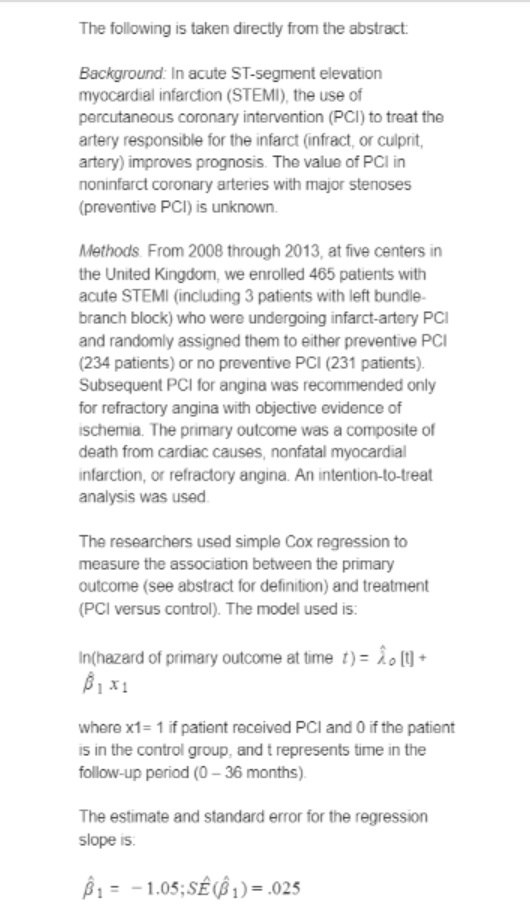The following is taken directly from the abstract: Background: In acute ST-segment elevation myocardial infarction (STEMI), the use of percutaneous coronary intervention (PCI) to treat the artery responsible for the infarct (infract, or culprit, artery) improves prognosis. The value of PCI in noninfarct coronary arteries with major stenoses (preventive PCI) is unknown. Methods. From 2008 through 2013, at five centers in the United Kingdom, we enrolled 465 patients with acute STEMI (including 3 patients with left bundle- branch block) who were undergoing infarct-artery PCI and randomly assigned them to either preventive PCI (234 patients) or no preventive PCI (231 patients). Subsequent PCI for angina was recommended only for refractory angina with objective evidence of ischemia. The primary outcome was a composite of death from cardiac causes, nonfatal myocardial infarction, or refractory angina. An intention-to-treat analysis was used The researchers used simple Cox regression to measure the association between the primary outcome (see abstract for definition) and treatment (PCI versus control). The model used is: In(hazard of primary outcome at time t) = 1. [!) + $1 x1 where x1= 1 if patient received PCI and 0 if the patient is in the control group, and t represents time in the follow-up period (0 - 36 months) The estimate and standard error for the regression slope is: B1 = - 1.05; SE (81)= .025. What does the function Inga (t)) represent in the Cox regression equation? The hazard of the primary outcome in the PCI group at time = 0 in the follow-up period. The ln(hazard) of the primary outcome in the control group at time=0 in the follow-up period. The ln(hazard) of the primary outcome in the control group as a function of time across the follow-up period The difference in the ln(hazard) of primary outcome between the PCI and control groups at time=0 in the follow-up period. . What assumption did the researchers make in order to use Cox regression to quantify the relationship between the primary outcome and PCI (versus control} ? .0 The relationship between the primary outcome and PCI is statistically significant. The hazard of the primary outcome is constant over time in both the PCI and control groups. PCI will reduce the hazard of the primary outcome by at least 20%. The ratio of the hazard of the primary outcome for the PCI group compared to the control group is constant over the 36 month follow-up period. . What is the estimated hazard ratio of the primary outcome for the PCI group compared to the control group, and the 95% Cl, based on the results from this research? 1.05 (0.55, 1.55) 0.35 (0.21, 0.58} 2.86 (1.55, 3.56} This cannot be answered without being given a specic time, and value of In (103)) at this specied time








